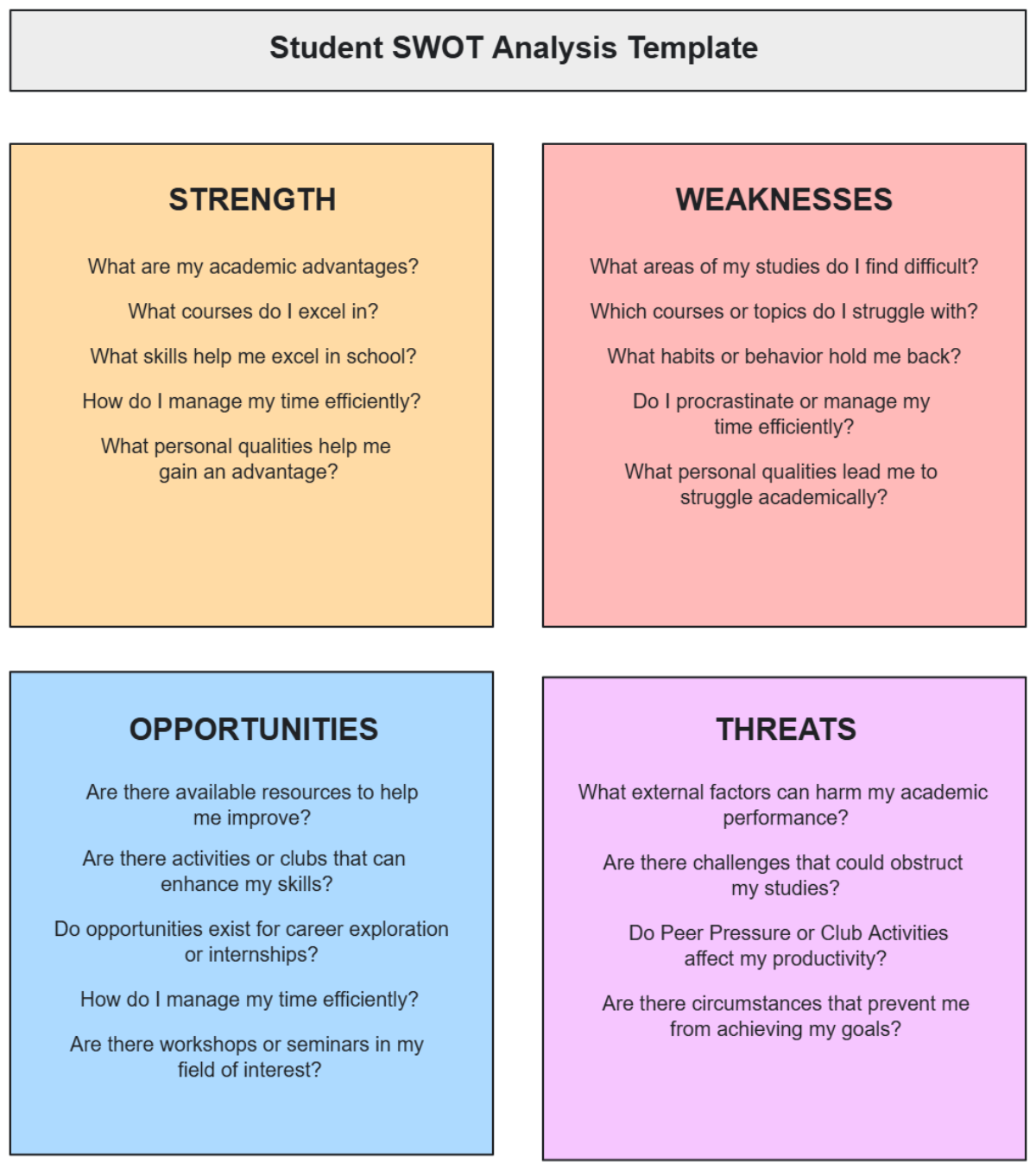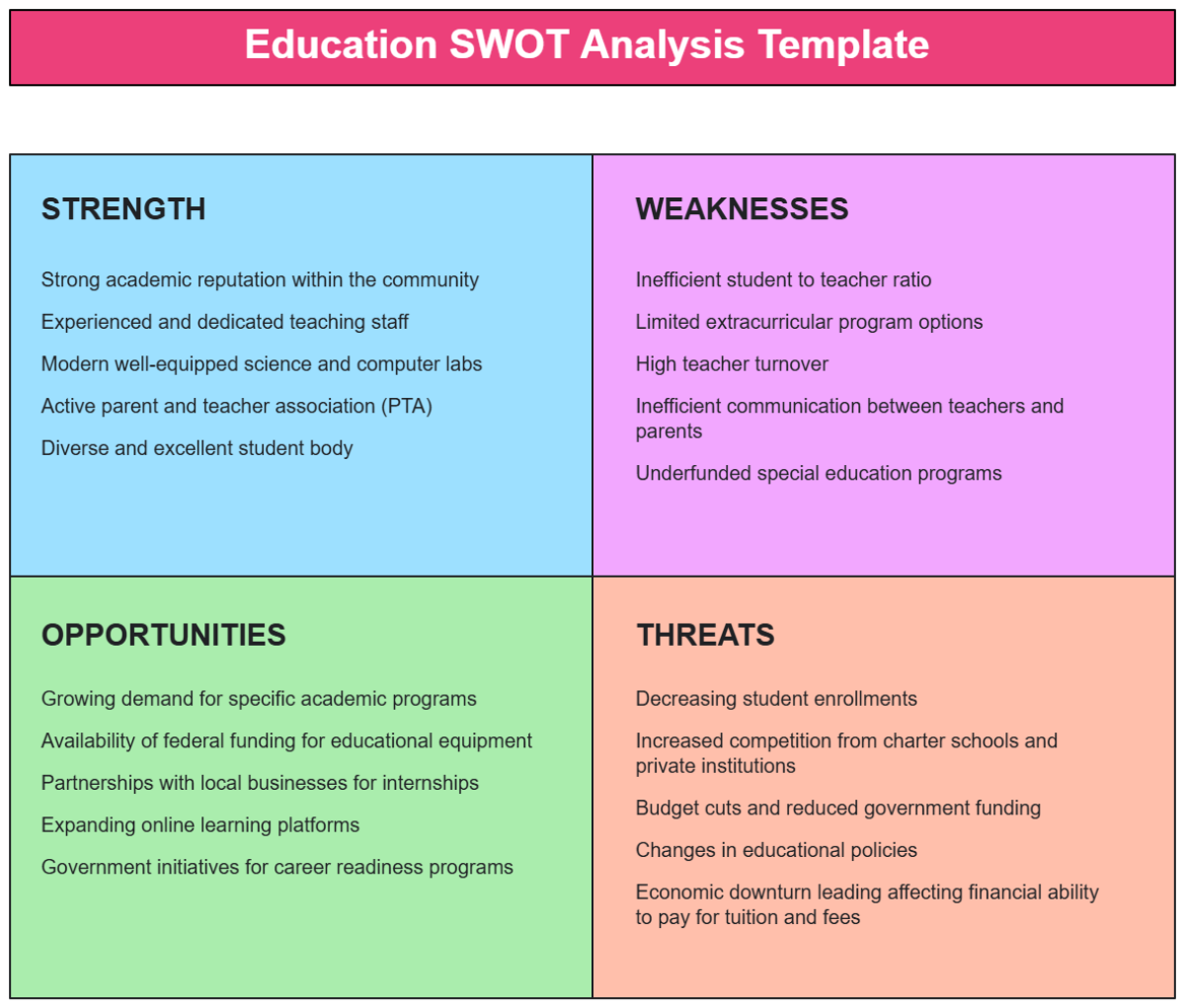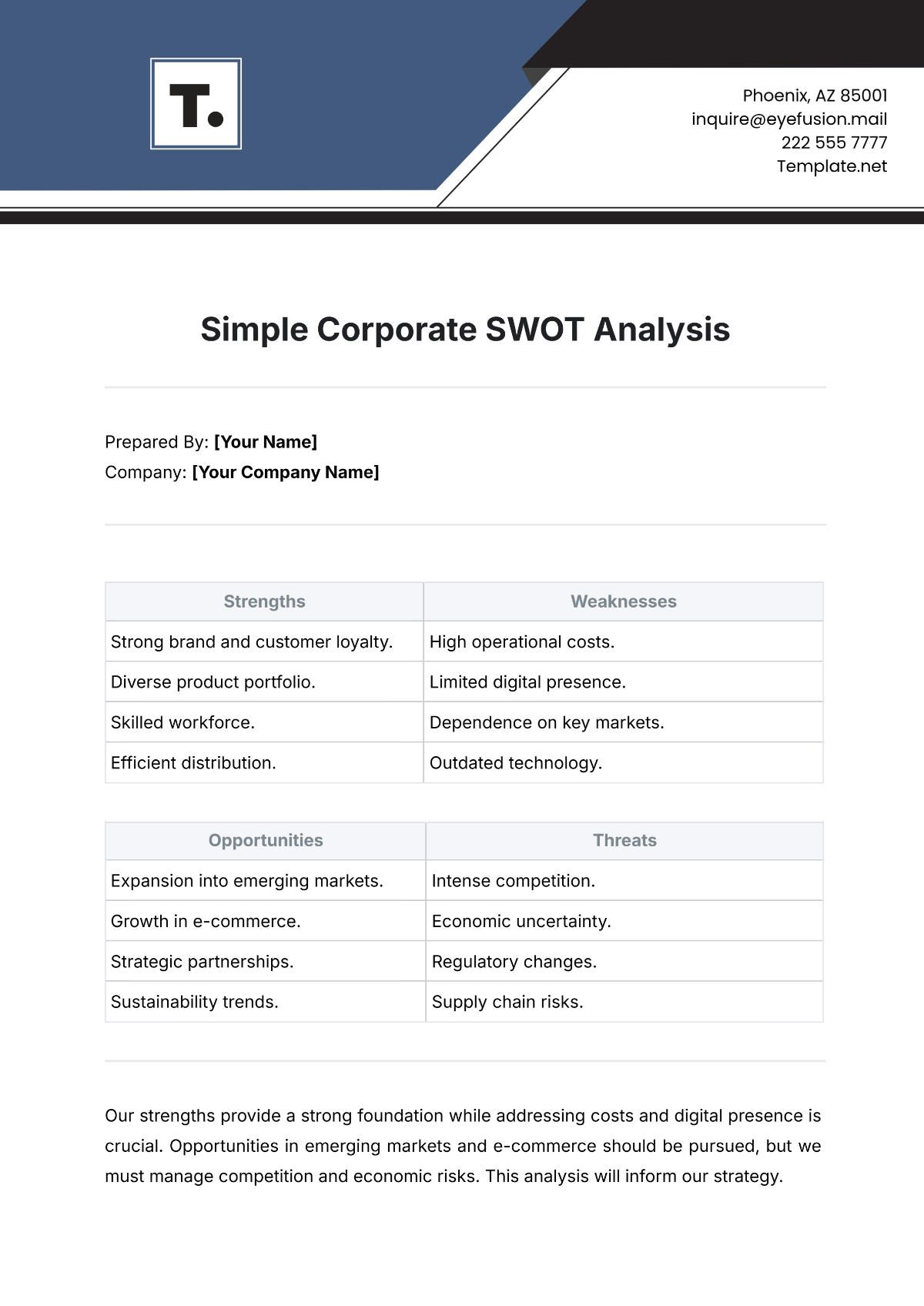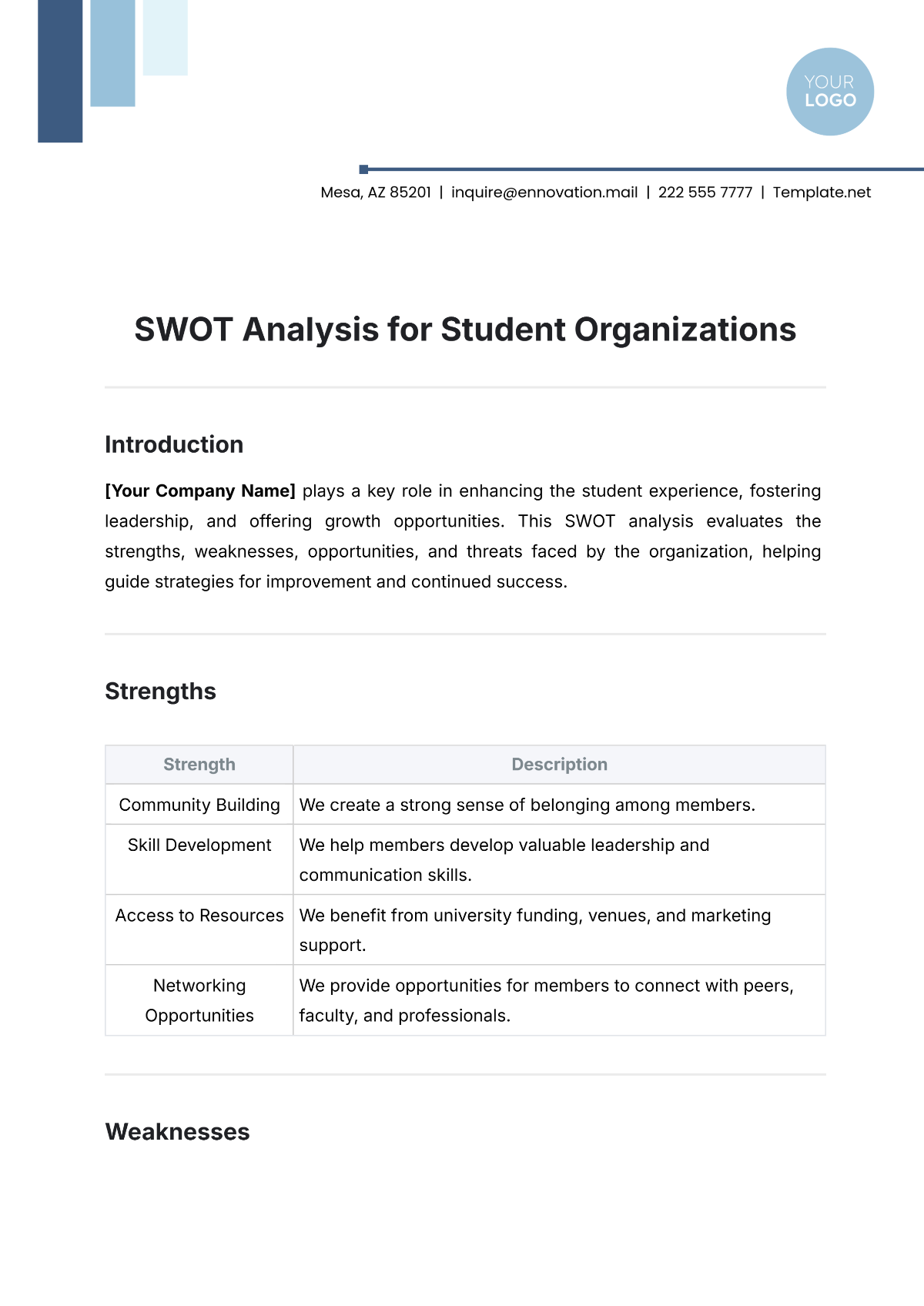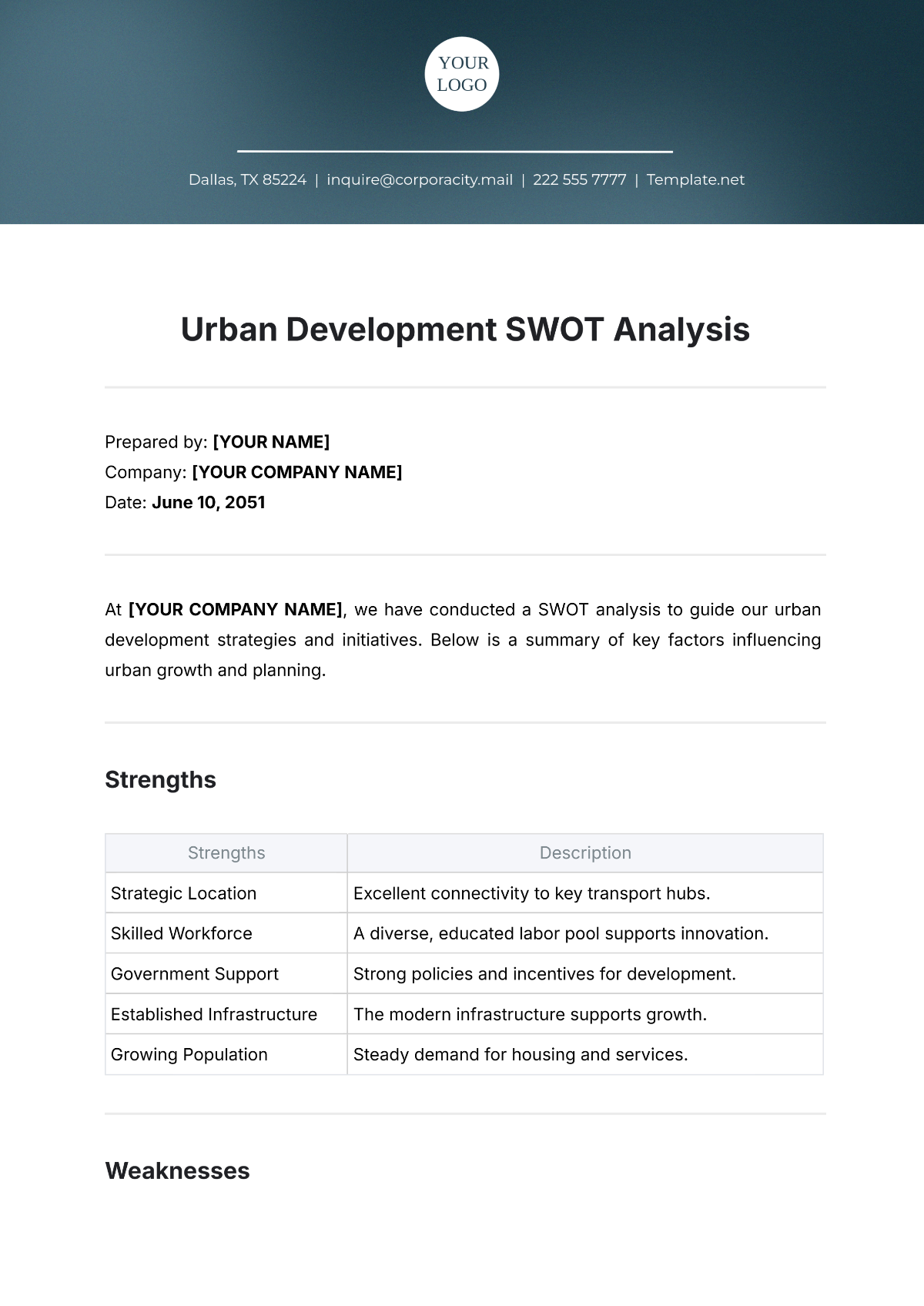Departmental Performance SWOT Analysis
TABLE OF CONTENTS
Executive Summary .......................................................................................................3
SWOT Analysis Table .....................................................................................................3
Strengths (S) ..................................................................................................................3
Weaknesses (W) ............................................................................................................4
Opportunities (O) ...........................................................................................................4
Threats (T) ......................................................................................................................5
Strategic Priorities ........................................................................................................5
Action Plan ......................................................................................................................5
Strategic Priority 1: Maximize Digital Presence ..........................................................5
Strategic Priority 2: Skill Development ........................................................................6
Strategic Priority 3: Workflow Optimization ................................................................7
Strategic Priority 4: Market Research ..........................................................................7
Strategic Priority 5: Diversify Marketing Channels .....................................................8
Monitoring and Review ..................................................................................................9
Date | September 14, 2053 |
Department | Marketing Department |
Executive Summary:
The Departmental Performance SWOT Analysis for the Marketing Department of [Company Name] is conducted to assess the current state of the department, identify internal strengths and weaknesses, and recognize external opportunities and threats that can impact performance. This analysis will inform strategic planning and guide efforts to enhance the effectiveness and efficiency of the Marketing Department.
SWOT Analysis Table:
STRENGTHS | WEAKNESSES |
|
|
OPPORTUNITIES | THREATS |
|
|
Strengths (S):
Experienced Team | The Marketing Department boasts a highly skilled and experienced team, including content creators, designers, and digital marketing specialists |
Strong Brand Identity | Our organization has established a strong and recognizable brand identity in the market |
Effective Content Strategy | The department has successfully implemented a content marketing strategy that has improved brand visibility and engagement |
Robust Analytics | We have access to advanced analytics tools for data-driven decision-making |
Solid Vendor Relationships | Strong partnerships with external vendors provide cost-effective solutions for marketing campaigns |
Weaknesses (W):
Resource Constraints | The department faces resource limitations, including budget constraints and staffing shortages |
Skills Gap | There is a need for training and skill development in emerging marketing technologies and trends |
Workflow Bottlenecks | Inefficiencies in project management and communication can cause delays in campaign execution |
Limited Market Research | Insufficient market research results in missed opportunities for targeted campaigns |
Overemphasis on Traditional Marketing | The department's focus on traditional marketing channels needs adjustment to align with evolving consumer preferences |
Opportunities (O):
Digital Expansion | The growing digital landscape offers opportunities for online marketing and e-commerce growth |
Market Expansion | Entering new geographic markets presents the potential for increased customer reach |
Data-Driven Personalization | Leveraging data analytics can enhance personalization and customer engagement |
Partnership Possibilities | Collaborations with complementary businesses can extend brand reach |
Sustainability Focus | Meeting consumer demands for sustainable practices aligns with emerging market trends |
Threats (T):
Competitive Landscape | The industry is highly competitive, with new entrants and well-established rivals |
Economic Uncertainty | Economic downturns and market fluctuations may impact marketing budgets |
Regulatory Changes | Evolving data privacy and advertising regulations can affect campaign strategies |
Technology Disruption | Rapid advancements in marketing technology may require significant adaptation |
Pandemic Uncertainty | Ongoing global health crises introduce market volatility and consumer behavior changes |
Strategic Priorities:
Maximize Digital Presence: Capitalize on opportunities in the digital landscape through improved online marketing and e-commerce initiatives.
Skill Development: Invest in training and development programs to bridge the skills gap and stay current with marketing trends.
Workflow Optimization: Streamline project management and communication processes to reduce inefficiencies.
Market Research: Enhance market research efforts to identify emerging trends and customer preferences.
Diversify Marketing Channels: Shift focus toward digital marketing channels while maintaining traditional marketing efforts.
Action Plan:
Strategic Priority 1: Maximize Digital Presence
Action Steps:
Conduct a comprehensive audit of the current digital marketing strategies and channels.
Identify areas for improvement in website optimization, SEO, and social media presence.
Develop a content calendar for consistent online engagement.
Explore opportunities for online advertising and partnerships with digital influencers.
Responsible Parties:
Digital Marketing Manager (Lead)
Content Creation Team
Social Media Specialists
SEO Analysts
Timelines:
Audit and assessment: October 1, 2053 - October 15, 2053
Website and SEO enhancements: November 1, 2053 - December 15, 2053
Content calendar implementation: January 1, 2054 - Ongoing
Online advertising and influencer collaborations: February 1, 2054 - Ongoing
Strategic Priority 2: Skill Development
Action Steps:
Identify specific skill gaps within the marketing team.
Develop a training plan that includes online courses, workshops, and certification programs.
Allocate time for ongoing learning and skill development.
Establish mentorship programs to encourage knowledge sharing.
Responsible Parties:
HR Department
Marketing Department Heads
Training and Development Coordinators
Timelines:
Skill gap assessment: September 15, 2053 - September 30, 2053
Training plan development: October 15, 2053 - November 15, 2053
Ongoing learning initiatives: December 1, 2053 - Ongoing
Mentorship program launch: January 1, 2054 - February 15, 2054
Strategic Priority 3: Workflow Optimization
Action Steps:
Review existing project management tools and systems for efficiency.
Identify bottlenecks and communication challenges in the workflow.
Implement a project management software solution.
Establish clear communication protocols and guidelines.
Responsible Parties:
Project Management Team
IT Department
Department Heads
Timelines:
Workflow assessment: November 1, 2053 - November 30, 2053
Project management software implementation: December 15, 2053 - January 31, 2054
Communication protocol development: February 1, 2054 - February 28, 2054
Strategic Priority 4: Market Research
Action Steps:
Allocate resources for market research activities.
Conduct regular surveys, focus groups, and competitor analysis.
Develop a database for storing and analyzing market data.
Share research findings with the marketing team for strategy adjustments.
Responsible Parties:
Market Research Team
Marketing Department Heads
Timelines:
Resource allocation: October 1, 2053 - October 15, 2053
Ongoing market research activities: November 1, 2053 - Ongoing
Database development: December 1, 2053 - February 28, 2054
Strategic Priority 5: Diversify Marketing Channels
Action Steps:
Identify the most promising digital marketing channels based on market research.
Adjust marketing budgets to allocate resources to new channels.
Launch pilot campaigns on selected digital channels.
Monitor and analyze the performance of new channels.
Responsible Parties:
Marketing Department Heads
Budgeting and Finance Team
Digital Marketing Specialists
Timelines:
Channel selection: November 15, 2053 - November 30, 2053
Budget adjustments: December 1, 2053 - December 15, 2053
Pilot campaign launch: January 15, 2054 - February 28, 2054
Ongoing performance analysis: March 1, 2054 - Ongoing
Monitoring and Review:
The process of conducting a Departmental Performance SWOT Analysis doesn't end with the initial assessment and action planning. It's essential to establish a robust framework for ongoing monitoring and review to ensure that the identified strategies remain relevant and effective in an ever-evolving business landscape.
Regular SWOT Assessment: Schedule regular SWOT assessments, such as quarterly or semi-annual reviews, to revisit the department's strengths, weaknesses, opportunities, and threats. This process will help you stay up-to-date with changing internal and external factors.
Key Performance Indicators (KPIs): Define and track specific KPIs related to each strategic priority. These KPIs should be measurable and align with the department's objectives. Regularly analyze KPI data to assess the progress of implemented strategies.
Feedback Mechanisms: Encourage feedback from departmental team members, stakeholders, and customers. Create an open and transparent feedback culture that allows individuals to share insights, concerns, and suggestions related to departmental performance.
External Environmental Scanning: Continuously monitor the external business environment for emerging trends, market shifts, regulatory changes, and competitive developments. This proactive approach will help the department adapt to new opportunities and threats.
Comparison to Benchmarks: Compare the department's performance and outcomes to industry benchmarks and best practices. Benchmarking can provide valuable insights into areas where improvement or innovation is needed.
Annual Review and Adjustment: Conduct a comprehensive annual review of the Departmental Performance SWOT Analysis. Evaluate the effectiveness of implemented strategies and consider adjustments based on changing circumstances and performance data.
Strategic Alignment: Ensure that departmental strategies remain aligned with the overall organizational goals and objectives. Periodically assess whether the department's priorities are in harmony with the organization's strategic direction.
Communication of Findings: Share the results of monitoring and reviews with relevant stakeholders, including department heads, senior management, and employees. Transparency in communication fosters a shared understanding of the department's progress.
Adaptive Strategy: Be prepared to adapt and modify strategies based on the findings of ongoing monitoring and review. If certain initiatives are not delivering the expected results, consider alternative approaches or reallocation of resources.
Continuous Improvement: Emphasize a culture of continuous improvement within the department. Encourage innovation and creative problem-solving to address challenges and capitalize on new opportunities as they arise.













